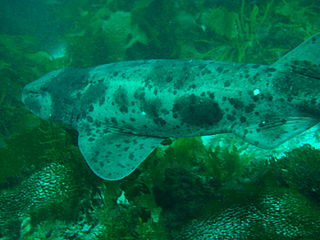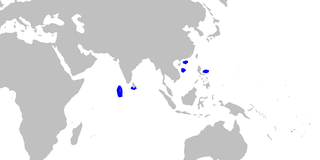
The Squaliformes are an order of sharks that includes about 126 species in seven families.
The Centrophoridae are a family of squaliform sharks. The family contains just two genera and about 15 species. They are sometimes called gulper sharks, but this is also the name of a specific species in the family, Centrophorus granulosus. These are generally deepwater fish. While some, such as the gulper shark C. granulosus, are found worldwide and fished commercially, others are uncommon and little-known. Their usual prey is other fish; some are known to feed on squid, octopus, and shrimp. Some species live on the bottom (benthic), while others are pelagic. They are ovoviviparous, with the female retaining the egg-cases in her body until they hatch.
Centrophorus is a genus of squaliform sharks. These deep-water sharks, found in temperate and tropical oceans throughout the world, are characterized by grey or brown bodies, large green eyes, and spines on both dorsal fins. These spines give them their name, from Greek κεντρον, kentron meaning "thorn" and φέρειν, pherein meaning "to bear".

The dumb gulper shark is a rare and endangered deepwater dogfish, known from only along the east coast of Australia and isolated spots north and west of New Zealand. It is also known as the dumb shark, Harrison's deep-sea dogfish, or Harrison's dogfish.

The lowfin gulper shark is a large deepwater dogfish in the family Centrophoridae.

The smallfin gulper shark is a medium-sized deepwater dogfish in the family Centrophoridae.

The leafscale gulper shark is a dogfish of the family Centrophoridae. C. squamosus is reported to have a lifespan of approximately 70 years, based on otolith ring counts. It was the first described species in the genus Centrophorus, which now contains 13 species.

The mosaic gulper shark is a small rare deepwater dogfish, found in the Pacific Ocean around Honshū, Japan and the Hawaiian Islands at depths between 260 and 728 m. It is one of 13 described species in the genus Centrophorus.

The little gulper shark is a small, deepwater dogfish of the family Centrophoridae.
Deania is a genus of long-snouted, deepwater dogfish sharks in the family Centrophoridae.

The gulper shark is a long and slender dogfish usually about three feet in length generally found in deep, murky waters all around the world. It is a light grayish brown, paler ventrally, with a long snout and large greenish eyes. This deep water shark has two dorsal fins with long, grooved spines and the second dorsal fin smaller than the first. Its upper teeth are blade-like and lower have finely serrated edges. This tertiary consumer feeds on mainly fish such as bony fish, but also cephalopods such as squid and other invertebrates like crustaceans. The gulper shark is currently a vulnerable species mainly because of exploitation by humans and their abnormally long gestation period and low fecundity, preventing their population from recovering.

The kitefin shark or seal shark is a species of squaliform shark in the family Dalatiidae, and the only species in its genus. It is found sporadically around the world, usually close to the sea floor at depths of 200–600 m (660–1,970 ft). With a sizable oil-filled liver to maintain neutral buoyancy, this shark is able to cruise slowly through the water while expending little energy. The kitefin shark, the largest luminous vertebrate on record, has a slender body with a very short, blunt snout, large eyes, and thick lips. Its teeth are highly differentiated between the upper and lower jaws, with the upper teeth small and narrow and the lower teeth large, triangular, and serrated. Its typical length is 1.0–1.4 m (3.3–4.6 ft), though examples as long as 5.9 ft (180 cm) have been encountered.

Cephaloscyllium is a genus of catsharks, and part of the family Scyliorhinidae, commonly known as swellsharks because of their ability to inflate their bodies with water or air as a defense against predators. These sluggish, bottom-dwelling sharks are found widely in the tropical and temperate coastal waters of the Indian and Pacific Oceans. They have stocky, spindle-shaped bodies and short, broad, and flattened heads. The mouth is capacious, containing many small teeth and lacking furrows at the corners. The two dorsal fins are placed far back on the body, with the first much larger than the second. Different species have various color patterns of saddles, blotches, reticulations, and/or spots. The largest members of the genus can grow over 1 m (3.3 ft) in length. Swellsharks prey on a variety of fishes and invertebrates, and are oviparous, with females producing egg capsules in pairs. They are harmless and have been deemed of having no commercial value.

Lamiopsis is a genus of shark in the family Carcharhinidae found in Indian and Pacific Ocean. This genus was previously considered to be monotypic. However, a recent taxonomic study revealed that the western central Pacific populations were a separate species.

The blackfin gulper shark is a dogfish of the family Centrophoridae in the Northwest Pacific. Threats are not entirely clear but they may be bycatching from deepwater trawling and line fisheries and may also be used for cod liver oil and fish meal.

The dwarf gulper shark is a dogfish of the family Centrophoridae found in the Indo-West Pacific oceans, from the Gulf of Aden, Japan, Taiwan, and northern Papua New Guinea. As a Squaliform, Centrophorus atromarginatus has high amounts of Squalene in its liver, and it is fished for this resource. It is a deep-water fish, whose habitat is in bathydemersal waters.

The Portuguese dogfish or Portuguese shark, is a species of sleeper shark of the family Somniosidae. This globally distributed species has been reported down to a depth of 3,675 m (12,057 ft), making it the deepest-living shark known. It inhabits lower continental slopes and abyssal plains, usually staying near the bottom. Stocky and dark brown in color, the Portuguese dogfish can be distinguished from similar-looking species by the small spines in front of its dorsal fins. Its dermal denticles are also unusual, resembling the scales of a bony fish. This species typically reaches 0.9–1 m (3.0–3.3 ft) in length; sharks in the Mediterranean Sea are much smaller and have distinct depth and food preferences.
Figaro is a genus of catshark, and part of the family Scyliorhinidae. Until 2008, Figaro was generally considered to be a subgenus of Galeus. The two known species are found off Australia, inhabiting deep, offshore waters on or near the bottom. Figaro contains small, slender, firm-bodied sharks that bear distinctive crests of enlarged, spiny dermal denticles along the dorsal and ventral edges of their short caudal fins. The caudal peduncle is relatively long, such as that the anal and caudal fins are some distance apart. In adult males, the inner margins of the pelvic fins are fused together to form a subtle "apron" over the claspers. F. boardmani is a predator of fishes, crustaceans, and cephalopods, and is oviparous; less is known about the F. striatus. Both are harmless and are of no economic importance.

The western gulper shark is a species of squaliform shark discovered in 2008. The species had previously been identified as a variant of the dumb gulper shark, however was differentiated based on morphology. The western gulper is known from the waters of Western Australia, as well as Indonesia, East Timor, and islands in the Southern Indian Ocean. This shark is classified as "least concern" by the IUCN.















